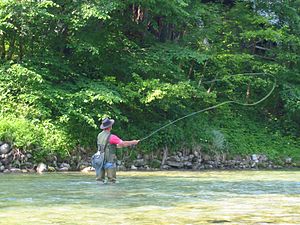 Image via Wikipedia
Image via Wikipedia
Today’s fishing rods have incorporated modern features that are not typical of the more primitive cane pole. Modern fishing rods contain reels, which aid in the retrieval of fish caught in its bait.
A much-sophisticated feature is the spinning rod where the entire shaft of the rod except the handle can move around on its axis to allow flexibility when fish caught on snare bait struggles through the water.
Like the classic cane fishing rods, the fishing gadget is thick at the handle (bottom) and is tapered and thinner at the tip. This very basic design allows handling stability and flexible movement of the entire length of the shaft.
Types of Fishing Rods and Specifications
A typical fishing rod measures 6 and 16 feet (2 and 5 m) and vary in capability to tolerate strain in fishing activity. The length has a lot to do with withstanding force exerted by the fish to the pole and determines for the most part the performance of rods used for angling.
Cane Poles
Cane poles are one of the smallest and less sophisticated gadgets in fishing. It is usually made of bamboo or other flexible wood material with the most basic fly line attached to it.
Unlike other more sophisticated fishing rods, cane poles do not usually contain reels or its equivalent to be used for reeling in or retrieving fish caught on bait. This very same action is known as angling.
Spinning Rods
These types of rods are the most popular today. They can be used either for heavyweight or lightweight fish although they were proven best for trout, walleye and bass fish. They vary in measurements from 5 and 7 feet (1.5 and 2.5 m).
Spinning poles are commonly used in bass fishing competition accounting for their flexibility and tolerance to stress. They accommodate bigger and tougher fly lines and stabilize them to avoid line tangles during uncoiling of float lines.
Jigging Rods
These rods are best for heavy lures and baits especially when reaching around 180 to 200 feet under the ocean’s surface. They are made of fine, solid materials which accounts to their heaviness. The use of jigging rods is specifically due to alternating currents during the fishing activity.
Some oceans have erratic undersea current. That is why the bait and fly lines should be kept in place. Lures are also disturbed and cause confusion among fish if the lines are not long and heavy enough to withstand and tolerate water currents under the sea.
These rods are best for target fishes usually found dwelling at the bottom of the sea such as halibut and cods.
See you on the water,
--Greg
"Please notify me of any new posts"

![Reblog this post [with Zemanta]](http://img.zemanta.com/reblog_e.png?x-id=bccfb17f-d53e-4580-9ff2-94c5ab89e117)


No comments:
Post a Comment